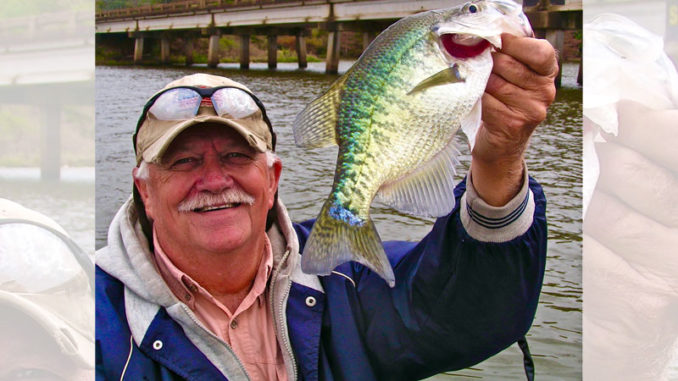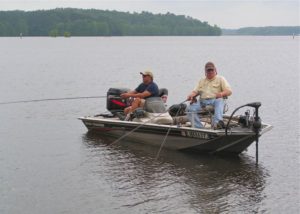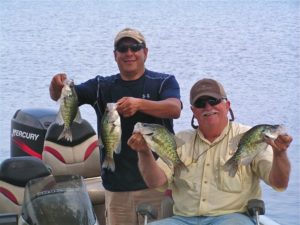
If you’re having trouble catching D’Arbonne crappie, this angler has the answers. And he doesn’t mind sharing all of his secrets.
Facing an empty livewell? Don’t know where to turn to catch a mess of crappie? Feel like giving up? Don’t despair.
Just call Sam!
Many North Louisiana residents have probably seen long-running television advertisements for a local attorney with a catchy jingle and a prompt to “Call Sam” to cure all of your legal troubles.
West Monroe’s Sam Roberson is not an attorney and he can’t help end your legal troubles, but he can help you catch more crappie.
And, even if you don’t call this Sam, you can learn a lot just by listening to him.
Roberson loves to show others how to catch crappie, and he doesn’t mind giving you the latest report. In fact, he shares colors, depths and the hottest techniques several times a week on his “Seekers of Men” Facebook page.
He looks forward to answering messages from the page — as soon as he is back in from the lake and done catching fish for the day
“I have been extremely blessed in my life, and I decided a while back to help share everything I know about fishing and help others catch more fish,” Robverson said. “I also established Seekers of Men because as I share my crappie tips — if people want to listen — I share my Christian beliefs, as well.”
This is the retired electrician’s favorite time of year to fish.

“I love cold-weather fishing,” Roberson said. “And when the cold-weather bite is on, I love to load up my gear and head to Lake D’Arbonne, get out my jig pole and start working the edges of the channels.
“It’s one of the best places to catch fish — not just in Louisiana, but in the country.”
Sam keys on 20- to 30-foot-deep water, putting his lures anywhere from 12 to 18 feet deep. He depends on his electronics to keep him close to the edge of the channel where there are old stump lines and other structure.
The equipment also helps him locate schools of shad.
“When you see those big balls of shad on the screen, you know crappie aren’t far away,” Roberson said.
During the winter, the hard-core angler follows a simple pattern.
He fishes one or two poles in his hands, with maybe one in a pole holder. He works areas he knows to hold crappie very slowly, and he uses plastic jigs on round-headed jigheads.
He works areas until he finds fish, and then stays with them.
But, unlike most area fishermen, Roberson doesn’t use any kind of niblets and he doesn’t use shiners.
Stepping into a boat looking for crappie with Roberson is like running a foot race: You better be ready to come out of the blocks strong.
The first time I did that, he had six fish in the boat before I even knew what depth I was fishing.
So what’s Roberson’s best tip?
“You’ve got to go to catch fish,” he said. “And, in most areas, if you don’t know what to do, just watch what other people are doing.
“How deep are they fishing? Are they fishing open water, trees, around docks? What lures are they using?”
Colors like blue grass, monkey milk, glitter critter and penny back are some of Roberson’s winter favorites for plastic trailers.
He also uses 1/16-ounce heads so he can get his lure down to the fish. And to make sure it stays down, he often uses a No. 2 split shot for extra weight.
He often uses unpainted heads, but pink is OK.
When all else fails, Roberson said most crappie fishermen don’t even mind you asking for help, especially when fish are in the channels.
“Crappie fishermen are a different breed,” he said. “They aren’t that secretive because when you are really on the crappie there are usually quite a few of them to be caught. Second, that’s just the way they are.”
When fishing for crappie deeper, it is important to keep your jig down where the fish are. Roberson uses larger weights and often double jigs, which add weight and gives the fish a second target to munch down on.
He always attaches the jigs with loop knots so they will sit upright and look more natural in the water.
The angler isn’t boastful about his fishing: He sums up his crappie fishing philosophy in one simple statement.
“There are a whole lot of fishermen who catch more crappie than I can, but there aren’t any that love it any more than I do,” Roberson said.
That became apparent as he put his foot on the trolling motor pedal and headed his aluminum Bass Tracker back into the wind, trying to hold us over a school of crappie roaming around about 18 feet below the boat in the old D’Arbonne channel.
“We are going to find them again here in a few minutes,” Roberson promised.

After a couple of hits and misses, he finally hooked 11/2-pound fish. A minute later I had one. Before the morning was over, we caught a great mess of fish; we kept the good ones, and let the others go and grow.
Even next month, when some fish start moving shallow, Roberson will stick with channel fish. He said they don’t all move into spawning grounds at the same time, and it isn’t unusual to keep catching deepwater fish all the way up until March.
This month will be a bit challenging for fishermen because Lake D’Arbonne has been drawn down 5 feet for most of the winter.
It is expected to be coming back up to normal by now, but that depends on winter rainfall.
Either way, the fish will be in the channels.
“You can depend on catching crappie in the channels, first of all because that’s where they always are this time of year and, second, because we know for sure that’s where there will be plenty of water,” Roberson said.
The biggest challenge following a drawdown isn’t the fish but the mental aspect of it for the fishermen.
“Don’t overthink it,” Roberson advised. “I have never seen a drawdown slow down the January fishing. It may change some patterns, but not a whole lot.
“Besides, when they close the gates on this lake, it doesn’t take but one or two good rains in the region and it will be full again.”
Roberson reminded fishermen that crappie sometimes will just lay right on the bottom in the winter. If he doesn’t see them on his electronics, he will start by putting his lures on the lake’s floor and work up until he finds a fish or two — and then he sticks with that depth.
Another of his tips is that crappie always feed up, so you want to keep the lure a foot to 18 inches above where the crappie are hanging out. Go 6 inches below them and you won’t get a bite, unless they hit it on the fall.
So if you see Sam on the lake, feel free to ask him what he’s doing. He won’t mind.
And he will always leave you with the same words he ends his posts online: “Catch you later — crappie, that is.”
Related info:
‘Don’t pass up a bridge,’ crappie angler says